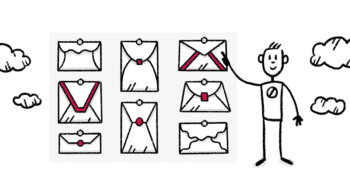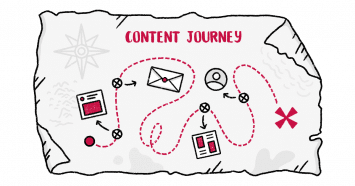The Rule of 40: The SaaS Magic Number & What It Means

The SaaS world is full of terminology and vague acronyms that you’ll want to know before you get started. You’ve got ACLS (annual contract values), CBI, (customer behavior index), SQLs (sales qualified leads), and more.
You may know these… but do you know about the rule of 40?
The rule of 40 is considered by many to be the SaaS “Magic Number,” and in this post we’re going to look at why that is, whether or not it’s really the magic number people think it is, and how you can progress towards your own rule of 40 success.
What is the Rule of 40 & Why Does It Matter?
The rule of 40 is a well-known principle for SaaS brands that states that the ideal growth rate and profit margins should be over 40% when combined. This is a simple metric of success, but one that’s often regarded as fact.
In simple terms, what this means is that you need to add your growth rate percentage over a certain time period and your profit margin percentage, and if it’s over forty, your brand is growing successfully.
You’re theoretically more stable, both in terms of growth and finances, and a safer horse to bet on.
Some use this to assess when SaaS companies have made it out of that startup peril, where they’re trying to aggressively grab users and build their userbase while getting started. It also helps brands keep their eye on long-term viability.
And even if you don’t put much stock into the rule of 40 as the SaaS magic number yourself, it’s worth pointing out that your opinion may not be the only one that matters. Equity investors and potential buyers may choose to turn to the rule or 40 when making their decisions, so it can directly impact funding opportunities.
Why the Rule of 40 is the SaaS Magic Number
So why is the rule of 40 so established as the tipping point for success, and where the heck did it come from?
The rule of 40 was made popular sometime around 2015 by venture capitalists who wanted to assess long-term viability and short-term rapid growth.
Plenty of SaaS tools, after all, start strong but then fade off fast. Their initial growth rates are aggressive, but they aren’t able to maintain either retention rates or growth rates (or both), and then they end up burning out.
The rule of 40, therefore, is used to help determine the long-term potential health of a SaaS tool so that investors don’t get fooled by a promising first quarter or first year just to wind up worse for the wear.
And while this metric is primarily used by investors or buyers who want to acquire the tool, it can actually be useful for the SaaS brands themselves. You can get a solid idea of how much your growth investments are working to attract high-quality, long-retaining clients. This is what’s crucial to not only grow a brand quickly, but to grow one sustainably and avoid either stagnation or decline.
How to Calculate the Rule of 40 For Your SaaS Company
Calculating the rule of 40 for your SaaS brand is actually very easy.
You can use the following formula:
Growth rate + Profitability Margin = >40
>40 = Successful SaaS tool
To break this down a little further:
- Calculate growth rate by subtracting your total value now from the value from the previous period and then multiply it by 100. Or:
- [Year 2 Total value – Year 1 Total value] x 100 = Growth Rate
- Note that total value may be ARPU, recurring revenue, or number of users depending on what’s being asked; it many cases, you’re going to be looking at recurring revenue
- Calculate profitability margin by subtracting your total expenses from your total revenue, and then dividing that by total revenue. Or:
- [Total revenue – Total expenses] / Total Revenue = Profitability Margin
As a quick note: If you want to manipulate the numbers a bit, you can intentionally choose high-value, high-profit periods. While year-over-year is commonly used, you may be able to look at quarter-over-quarter or month-over-month numbers, especially if you’ve recently had a significant push for growth or in revenue. This will depend on what information you’re giving and to whom.
What is the Weighted Rule of 40?
Want to make things just a touch more complicated?
There’s such a thing as a weighted rule of 40.
The commonly-accepted weighted rule of 40 gives twice the amount of weight to growth than profitability. This is particularly common in smaller SaaS companies that are still gaining their footing and that are working to scale to a new level.
The formula to calculate this is:
(1.33 x Revenue Growth) + (.67 x EBITDA Margin) = Weighted Rule of 40
Your EBITDA (earnings before interest, taxes, and amortization) assesses profit from operations and helps to get a better understanding of your cash flow. The EBITDA margin divides EBITDA by your revenue.
This metric, therefore, can give a more realistic and functional look at the financial health of a SaaS company as it currently stands while allowing rapid growth rates to work in the favor of the new companies.
And the reality is that as companies grow to scale, it will be almost impossible to grow at the same level of scale. It’s much easier to go from one user to a thousand users than it is to go from one million to ten million, for example. Growth rates will reflect that, so some experts recommend using an alternative weighted rule of 40 in these circumstances that prioritize EBITDA margin over growth.
3 Tips to Move Towards the Rule of 40 for SaaS Brands
If you’ve run the calculations and you’re not quite where you want to be in terms of hitting that rule of 40 metric of success, the good news is that there are always changes you can make to get there.
While SaaS brands are all unique (so there’s no one true one-size-fits-all approach necessarily), the following tips can help you get closer to tipping the scales in your favor past 40:
- Figure out who your high-value users are. You’d be amazed how many SaaS tools don’t know (or wrongly guess) who their highest-value users are. These can be users who purchase the highest-level plan, but they might also be users who retain the longest at the lowest level plan.
A client of mine once was sure that their enterprise-grade, 1k a month clients were their golden ticket to success, until we looked at the analytics. They actually had freelancers as their primary high-value user base; even though many stuck with the base plan, they retained for years and each one referred an average of five other users who would convert over their lifetime. - Optimize your entire customer journey for retention. Acquisition gets a lot of attention when you’re looking at growth, but a growing user base is most beneficial and stable when some (ideally most) of those existing users stick around.
This means that you don’t want to focus exclusively on acquisition; make sure that your onboarding is great, that you’ve got re-engagement campaigns, and great support. You need to do more than just get users to sign up for that free trial. - Market heavily as needed. Different types of marketing campaigns have their own pros and cons. Content marketing, for example, can be insanely valuable… but it’s often a long-term play that can take months to see results. PPC ads may cost more, but they can drive immediate results as long as you’re willing to pay for them. Test out different platforms and see what works to deliver high levels of your target audience.
Final Thoughts
The rule of 40 isn’t the only metric that means that your brand is or will be successful… but it also doesn’t hurt, especially when you’re courting investors or potential buyers.
And while the growth rate is always a huge focus, remember that you can’t have growth without retention and engagement. Make sure that your digital sales funnel isn’t just set up to acquire new users but also to retain them; that will be a significant part of success with your SaaS brands, both in regard to rule of 40 and otherwise.


